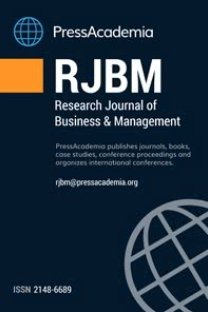STUDENTS’ CARRIER PREFERENCES AFTER IMPLEMENTATION OF MOBILE NUMBER PORTABILITY
Purpose - This paper investigates the extent to which the implementation of mobile number portability affects the customer churn in the short run and long run. The aim is to calculate the market shares of the operators based on students’ operator preference rates for the first six months and the first 18 months of the implementation period and to predict operators' future market share under the assumptions that students will continue to behave the same in preferring operators and firms’ policies will remain unchanged. Methodology - A face-to-face questionnaire was administered to 1709 students at Cukurova University in 2017. Subscriber changes in the first six months after the implementation and in the first 18 months after the implementation were analyzed for the possibility that subscribers might react later. Using the Markov chain method, the transition probability matrix showing the market share of the three mobile telephone service providers was constructed and the stationarity matrix was calculated. Findings- After six months from the introduction of mobile number porting, Turkcell has the highest customer retention rate with 91.7% followed by Avea (now merged with and owned by Turk Telekom) with 3.3% difference and Vodafone with 6.9% difference. After 18 months from the introduction of mobile number porting, customer retention rates of the three operators were balanced at about 91%, and operators lost customers to each other at about the same rate. Conclusion- Turkcell will maintain its leadership in the short run with a decrease in its market share and the market share of the three operators will be balanced in the long run.
Keywords:
Customer churn, Market share, Customer preference Markov chain, Stationarity,
___
- Adebiyi, S.O., Oyatoye, E.O. & Mojekwu, J.N. (2015). Predicting customer churn and retention rates in Nigeria’s mobile telecommunication industry using Markov chain modelling. Acta Univ. Sapientiae, Economics and Business, 3, pp.67-80.
- Bagdadioglu, N.& Cetinkaya, M. (2010). Sequencing in telecommunications reform: A review of the Turkish case. Telecommunications Policy, 34, pp.726-735.
- Beuhler, S., & Haucap, J. (2004). Mobile number portability. Journal of Industry, Competition and Trade, vol. 4, no. 3, p.223-238.
- Çam, S., & Kılıç, S.B. (2018). Altın fiyatı günlük getirilerinin yapay sinir ağları algoritması ve Markov zincirleri modelleri ile tahmini. Uluslararası İktisadi ve İdari İncelemeler Dergisi, özel sayı. 18.EYİ, s.681-694.
- Farg, M. H. M., & Khalil, F. M. H. (2014). Statistical Analysis of Academic Level of Student in Quantitative Methods Courses By Using Chi-Square Test and Markov Chains - Case Study of Faculty of Sciences and Humanities, Nature and Science, vol.12, no.12, p.182-186. http://www.sciencepub.net/nature/ns1212/024_27755ns121214_182_186.pdf (19.03.2018)
- Genç, A., & Narin, M. (2016). Türkiye'de Mobil Numara Taşınabilirliği Uygulamasının Fiyat ve Rekabet Üzerine Etkileri: Panel Veri Analizi. Uluslararası Ekonomi ve Yenilik Dergisi, cilt.2, sayı.2, s.91-116.
- Grimshaw, S. D., & Alexander, W. P. (2011). Markov Chain Models for Deliquency: Transition Matrix Estimation and Forecasting. Applied Stochastic Models in Business and Industry, 27, p.267-279.
- Güngör, M. & Evren, G. (2010). Mobil numara taşınabilirliği: Rekabete ve tüketicilere etkileri. Bilgi Teknolojileri ve İletişim Kurumu Sektörel Araştırma ve Stratejiler Dairesi Başkanlığı, Ankara. http://www.btk.gov.tr/Yayin/Raporlar/2010/DEA_MNT_v4.pdf (22.03.2018)
- Karabag, S. F. & Berggren, C. (2011). Mobile communications in Turkey: from first mover advantages to management capabilities. Emeraldinsight, cilt.13, sayı.2, s.72-84. https://www.emeraldinsight.com/doi/pdfplus/10.1108/14636691111121647 (20.03.2018)
- Kıral, E. (2018). Markov Analizi ile cep telefonu operatör tercihlerinin belirlenmesi: Adana ili üzerine bir uygulama. Çukurova Üniversitesi Sosyal Bilimler Enstitüsü Dergisi, Basım aşamasında.
- Kıral, E., Mavruk, C. & Kıral, G. (2018). Ekonometri öğrencilerinin sayısal derslerdeki akademik performansı: Markov modeli ile bir hesaplama. Uluslararası İktisadi ve İdari İncelemeler Dergisi, özel sayı. 18.EYİ, s.617-632.
- Kıral, E. & Uzun, B. (2017). Forecasting Closing returns of Borsa İstanbul index with Markov chain process of the fuzzy states. Journal of Economics, Finance and Accounting, vol. 4, no.1, p.15-24.
- Lazri, M., Ameur, S., Brucker, J. M., Lahdir, M., & Sehad, M. (2015). Analysis of drought areas in Northern Algeria using Markov chains, J. Earth Syst. Sci., vol.124, no.1, p.61–70.
- Lukić, P., Gocić, M. & Trajković, S. (2013). Prediction of annual precipitation on the territory of South Serbia using Markov chains. Bulletin of the Faculty of Forestry, 108, p. 81-92.
- Lyons, S. (2010). Measuring the effects of mobile number portability on service prices. Journal of Telecommunications Management, cilt.2, sayı.4, s.357–368.
- Mavruk, C., ve Kıral, E. (2016). Academic progress of students ın quantıtatıve courses at Nigde Unıversıty Vocatıonal School Of Socıal Scıences: a predıctıon usıng Markov model. Niğde Ömer Halisdemir Üniversitesi İktisadi ve İdari Bilimler Fakültesi Dergisi, cilt. 9, sayı.3, s.267-278.
- Pehkonen, J., & Tervo, H. (1998). Persistence and Turnover In Regional Unemployment Disparities. Regional Studies, 32(5), 445-458.
- Sánchez, B.U. & Asimakopoulos, G. (2011). Regulation and competition in the European mobile communications industry:An examination of the implementation of mobile number portability. Telecommunications Policy, 36, s.187-196.
- Saptnekar, M. A., & Digge, R.B. (2017). Mobile number portability. Asian Journal of Convergence in Technology, 1(5). https://doi.org/https://doi.org/10.1212/ajct.v1i1.99 (21.03.2018)
- Sharma, V., Kapse, M., & Sonwalkar, J. (2016). Predicting the Consumers’ Brand Switching Behavior for Cellphones: Application of Markov Chain Models. The IUP Journal of Marketing Management, cilt.15, sayı.4, s.31-43.
- Shin, D.H. (2006). A study of mobile number portability effects in the United States. Telematics and Informatics, 24, s.1–14
- Shin, D.H. & Kim, W. Y. (2007). Forecasting customer switching intention in mobile service: An exploratory study of predictive factors in mobile number portability, Technological Forecasting & Social Change. 75, s.854–874.
- Sutherland, W. (2007). Mobile number protability. Emeraldinsight, cilt.9, sayı.4, s.10-24.
- Yayın Aralığı: Yılda 4 Sayı
- Başlangıç: 2014
- Yayıncı: PressAcademia
